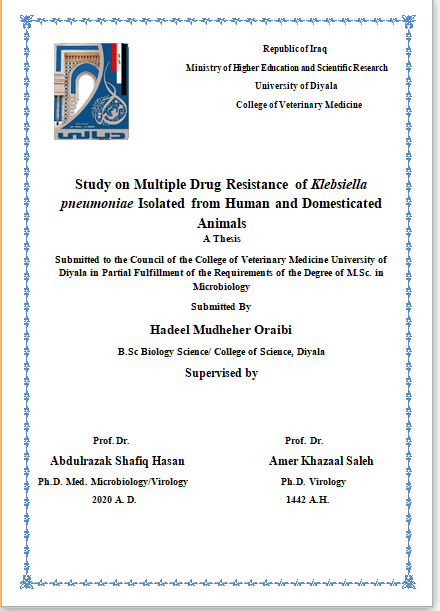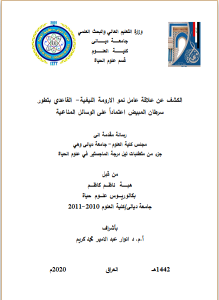Summary
Antimicrobial resistance is a global threat , with deaths associated with Antimicrobial resistance( AMR) infections are expected to exceed 10 million cases per year by the year 2050. The overuse and misuse of antibiotics is the primary driver of this resistance, with up to 50% of antibiotics prescribed in the hospital setting being either unnecessary or inappropriate. K.pneumoniae is a Gram-negative, non-motile, encapsulated, lactose– fermenter, facultative anaerobic, rod-shaped in the family Enterobacteriaceae. Klebsiella organisms are often resistant to multiple antibiotics. Plasmids are implicated as the primary source of the resistance genes. Klebsiella species which producing extended-spectrum beta-lactamases are resistant to virtually all beta-lactam antibiotics, except carbapenems. Aminoglycosides, Fluoroquinolones, Tetracycline, Chloramphenicol, and Trimethoprim/Sulfamethoxazole represent other frequent resistance targets. The Carbapenems resistant K. pneumoniae is emerging as an important challenge in health-care settings.
This is a cross sectional study conducted for the period from October 2019 to April 2020. The study included 293 human and animal samples. Human samples were obtained from patients suffering from different infections; 112 urine, 22 sputum, 8 burns, 11 wounds 22 stool and 7 blood samples. The age range of patients was 1-65 years; 77 were males and 105 were females. Human specimens were collected from Baquba Teaching Hospital, Al-Batool Teaching Hospital for Maternity and Children and from other health care centers. Human privacy was respected as verbal consents of patients were obtained. Whereas, animal samples were; 55 stool, 23 milk and 33 urine samples from different animal species (cow, sheep, goat and chicken).
Animal specimens were collected from several fields of animal husbandry poultry farms in the cities of Bani Saad, Baquba and from Veterinary clinic in Buhriz district. These samples were submitted for standard bacteriological culture using ordinary and selective media. Plates were incubated at 370C for overnight. Morphological inspection, microscopically examination, biochemical tests, and VITEK2 system were used to confirm bacterial identification. Statistical analysis was done on data accumulated throughout the study using SPSS, T-test & Chi square. P values less than 0.05 were considered significant.
A total of 41 confirmed isolates of K.pneumoniae were identified, 37 from human samples and 4 from animal samples. The antibiotic susceptibility test for K. pneumoniae isolates was performed against 14 antibiotics using disk diffusion method. All of the 37 human isolates (100%) were resistant to Rifampicin, Ampiclox and Methicillin. 16 (43.2%), were resistant to Ceftriaxone, 29 (78.4%) were resistant to Carbenicillin, 23 (62.2%) were resistant to Piperacillin, 15(40.5%), resistance to streptomycin, and 16 (43.2%) were resistance to Trimethoprim-Sulfamethozal. The rates of sensitivity to Imipenem Ciprofloxacin, Azithromycin, Levofloxacin, Nalidixic acid and Polymyxin B were (100%), 33 (89.2%), 31 (83.8%), 30 (81.1%), 21 (56.8%) and 25 (67.6%) respectively.
On the other hand, antibiotic susceptibility test for the 4 isolates of K. pneumoniae from animal were all(100%) resistant to Rifampicin, Ampiclox and Methicillin. Whereas, all isolates (100%) were sensitive to Ciprofloxacin, Imipenem, Azithromycin, levofloxacin and Polymyxin B. 3(75%) of the isolates were resistant to Carbenicillin and 2 (50%) were resistant to Trimethoprim-Sulfamethozal. Additionally, 1 (25%) of the isolates were resistant to Streptomycin, Nalidixi acid, Ceftriaxone and Piperacillin. The rate of multi-drug resistance phenotypes in K. pneumoniae human isolates was (70.2%), while it was (75%) for animal isolates.
Polymerase chain reaction ( PCR) technique was used in the detection of resistance genes in 30 isolates of K. pneumoniae (26 of human and 4 of animal ) by using primers for three resistance genes ( bla- CTX-M, bla –OXA ,and StrA). The findings showed that 15 human isolates had the bla- CTX-M genes, 2 isolates had bla –OXA genes, and 18 isolates had StrA gene. Whereas, only one isolate (25%) from animal samples had both bla- CTX-M and StrA genes, and all the isolates were devoid of the bla- OXA genes.
Automated DNA sequencer, for the resistance genes (StrA , bla-OXA , bla-CTX-M) of two isolates (one from human and the another from animal) were sequenced and compared with reference gene in Genbank. The DNA sequence of all the five resistance genes were 95-100% identical to DNA sequences of resistance gene from different species of Enterobacteriaceae bacteria and other bacterial species that were documented in the Genbank. Those five resistant genes diagnosed in the current study were recorded in the Genbank data bases.
The study concluded that multiple drug resistant(MDR) K. pneumoniae are prevalent among human population in Diyala community particularly in children and elderly hospitalized patients. Domesticated animals may play a role as an additional source of the MDR bacterium in the community





